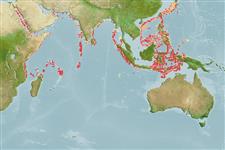Environment: milieu / climate zone / depth range / distribution range
Ecologia
marinhas bentopelágico; intervalo de profundidade 250 - 350 m (Ref. 6181). Deep-water; 31°N - 14°S, 32°E - 139°E (Ref. 6181)
Western Indian Ocean: Red Sea and west coast of India. Western Pacific: Timor Sea. This species has long been synonymized with Trichiurus lepturus.
Tamanho / Peso / Idade
Maturity: Lm ? range ? - ? cm
Max length : 42.4 cm TL macho/indeterminado; (Ref. 6181); common length : 23.0 cm TL macho/indeterminado; (Ref. 6181)
Espinhos dorsais (total) : 3; Raios dorsais (total) : 106 - 116; Raios anais : 80. Body extremely elongate, compressed and tapering to a point. Mouth very large with a small dermal process at the tip of each jaw. Pelvic and caudal fins absent. Lateral line originating at the upper margin of the gill cover, running obliquely to behind the tip of the pectoral fins, then parallel to the ventral contour of the body. Fresh specimens are pearl white and slightly dusky dorsally; the margins of the dorsal and anal fins dusky in formalin.
Found in deep waters off Kerala and Tamil Nadu, India. Feeds on deep water shrimps and small fishes like myctophids and gonostomatids. Caught with deep water trawls mixed together with other commercially important fish as bycatch.
Ciclo de vida ou comportamento de acasalamento
Maturidade | Reprodução | Desova | Ovos | Fecundidade | Larvas
Nakamura, I. and N.V. Parin, 1993. FAO Species Catalogue. Vol. 15. Snake mackerels and cutlassfishes of the world (families Gempylidae and Trichiuridae). An annotated and illustrated catalogue of the snake mackerels, snoeks, escolars, gemfishes, sackfishes, domine, oilfish, cutlassfishes,. scabbardfishes, hairtails, and frostfishes known to date. FAO Fish. Synop. 125(15):136 p. (Ref. 6181)
Status na Lista Vermelha da UICN (Ref. 130435: Version 2024-2)
Ameaça para os humanos
Harmless
Uso pelos humanos
Pescarias: sem interesse
Ferramentas
Relatórios especiais
Baixar XML
Fontes da internet
Estimates based on models
Preferred temperature (Ref.
123201): 11 - 21.8, mean 12.2 °C (based on 49 cells).
Índice de diversidade filogenética (Ref.
82804): PD
50 = 0.5020 [Uniqueness, from 0.5 = low to 2.0 = high].
Bayesian length-weight: a=0.00191 (0.00078 - 0.00466), b=3.12 (2.91 - 3.33), in cm total length, based on LWR estimates for this (Sub)family-body shape (Ref.
93245).
Nível Trófico (Ref.
69278): 4.2 ±0.73 se; based on food items.
Resiliência (Ref.
120179): Baixo, tempo mínimo de duplicação da população 4,5 - 14 anos (Assuming tmax>10).
Fishing Vulnerability (Ref.
59153): Low to moderate vulnerability (32 of 100).
Nutrients (Ref.
124155): Calcium = 167 [42, 435] mg/100g; Iron = 0.939 [0.262, 3.001] mg/100g; Protein = 17.7 [15.9, 19.6] %; Omega3 = 0.285 [0.122, 0.695] g/100g; Selenium = 57.5 [16.1, 220.8] μg/100g; VitaminA = 5.47 [0.58, 46.73] μg/100g; Zinc = 0.834 [0.382, 1.501] mg/100g (wet weight);
